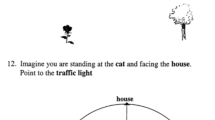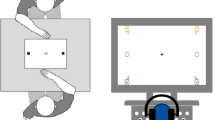Abstract
Accurate distinction between self and other representations is fundamental to a range of social cognitive capacities, and understanding individual differences in this ability is an important aim for psychological research. This demands accurate measures of self–other distinction (SOD). The present study examined an experimental paradigm employed frequently to measure SOD in the action domain; specifically, we evaluated the rotated finger-action stimuli used increasingly to measure automatic imitation (AI). To assess the suitability of these stimuli, we compared AI elicited by different action stimuli to the performance on a perspective-taking task believed to measure SOD in the perception domain. In two separate experiments we reveal three important findings: firstly, we demonstrate a strong confounding influence of orthogonal-compatibility effects on AI elicited by certain rotated stimuli. Second, we demonstrate the potential for this confounding influence to mask important relationships between AI and other measures of SOD; we observed a relationship between AI and perspective-taking performance only when the former was measured in isolation of orthogonality compatibility. Thirdly, we observed a relationship between these two performance measures only in a sub-group of individuals exhibiting a pure form of AI. Furthermore, this relationship revealed a self-bias in SOD—reduced AI was associated with increased egocentric misattributions in perspective taking. Together, our findings identify an important methodological consideration for measures of AI and extend previous research by showing an egocentric style of SOD across action and perception domains.



Similar content being viewed by others
References
Apperly, I. A., Carroll, D. J., Samson, D., Humphreys, G. W., Qureshi, A., & Moffitt, G. (2010). Why are there limits on theory of mind use? Evidence from adults’ ability to follow instructions from an ignorant speaker. Quarterly Journal of Experimental Psychology, 63, 1201–1217. doi:10.1080/17470210903281582.
Bertenthal, B. I., Longo, M. R., & Kosobud, A. (2006). Imitative response tendencies following observation of intransitive actions. Journal of Experimental Psychology Human Perception and Performance, 32(2), 210–225. doi:10.1037/0096-1523.32.2.210.
Bien, N., Roebroeck, A., Goebel, R., & Sack, A. T. (2009). The brain’s intention to imitate: The neurobiology of intentional versus automatic imitation. Cerebral Cortex (New York, N.Y.: 1991), 19(10), 2338–2351. doi:10.1093/cercor/bhn251.
Boyer, T. W., Longo, M. R., & Bertenthal, B. I. (2012). Is automatic imitation a specialized form of stimulus-response compatibility? Dissociating imitative and spatial compatibilities. Acta Psychologica, 139(3), 440–448. doi:10.1016/j.actpsy.2012.01.003.
Boyer, T. W., Scheutz, M., & Bertenthal, B. I. (2009). Dissociating ideomotor and spatial compatibility: Empirical evidence and connectionist models. In: Proceedings of the 31st annual conference of the Cognitive Science Society (pp. 2280–2285). Cognitive Science Society Austin, TX.
Brass, M., Heyes, C., (2005) Imitation: is cognitive neuroscience solving the correspondence problem? Trends in Cognitive Sciences, 9(10), 489–495.
Brass, M., Bekkering, H., & Prinz, W. (2001). Movement observation affects movement execution in a simple response task. Acta Psychologica, 106(1), 3–22.
Brass, M., Bekkering, H., Wohlschläger, A., & Prinz, W. (2000). Compatibility between observed and executed finger movements: Comparing symbolic, spatial, and imitative cues. Brain and Cognition, 44(2), 124–143. doi:10.1006/brcg.2000.1225.
Brass, M., Ruby, P., & Spengler, S. (2009). Inhibition of imitative behaviour and social cognition. Philosophical Transactions of the Royal Society of London Series B Biological sciences, 364(1528), 2359–2367. doi:10.1098/rstb.2009.0066.
Bruyer, R., & Brysbaert, M. (2011). Combining speed and accuracy in cognitive psychology: Is the inverse efficiency score (IES) a better dependent variable than the mean reaction time (RT) and the percentage of errors (PE)? Psychologica Belgica, 51(1), 5–13.
Butler, E. E., Ward, R., & Ramsey, R. (2015). Investigating the relationship between stable personality characteristics and automatic imitation. PLoS One, 10(6), e0129651. doi:10.1371/journal.pone.0129651.
Catmur, C., & Heyes, C. (2011). Time course analyses confirm independence of imitative and spatial compatibility. Journal of Experimental Psychology Human Perception and Performance, 37(2), 409–421. doi:10.1037/a0019325.
Catmur, C., Walsh, V., & Heyes, C. (2009). Associative sequence learning: The role of experience in the development of imitation and the mirror system. Philosophical Transactions of the Royal Society of London Series B Biological Sciences, 364(1528), 2369–2380. doi:10.1098/rstb.2009.0048.
Cho, Y. S., & Proctor, R. W. (2003). Stimulus and response representations underlying orthogonal stimulus–response compatibility effects. Psychonomic Bulletin and Review, 10(1), 45–73. Retrieved from http://www.ncbi.nlm.nih.gov/pubmed/12747491.
Cook, J., & Bird, G. (2011). Social attitudes differentially modulate imitation in adolescents and adults. Experimental Brain Research,. doi:10.1007/s00221-011-2584-4.
Cook, J. L., & Bird, G. (2012). Atypical social modulation of imitation in autism spectrum conditions. Journal of Autism and Developmental Disorders, 42(6), 1045–1051. doi:10.1007/s10803-011-1341-7.
Cooper, R., Catmur, C., & Heyes, C. (2013). Are automatic imitation and spatial compatibility mediated by different processes? Cognitive Science,. doi:10.1111/j.1551-6709.2012.01252.x/full.
Cross, K. A., Torrisi, S., Reynolds Losin, E. A., & Iacoboni, M. (2013). Controlling automatic imitative tendencies: Interactions between mirror neuron and cognitive control systems. Neuroimage, 83, 493–504. doi:10.1016/j.neuroimage.2013.06.060.
de Guzman, M., Bird, G., Banissy, M. J., & Catmur, C. (2016). Self–other control processes in social cognition: From imitation to empathy. Philosophical Transactions of the Royal Society B, 371(1686), 20150079. doi:10.1098/rstb.2015.0079.
Decety, J., & Lamm, C. (2007). The role of the right temporoparietal junction in social interaction: How low-level computational processes contribute to meta-cognition. Neuroscientist, 13, 580–593.
Der, G., & Deary, I. J. (2006). Age and sex differences in reaction time in adulthood: Results from the United Kingdom Health and Lifestyle Survey. Psychology and Aging, 21(1), 62–73. doi:10.1037/0882-7974.21.1.62.
Dumontheil, I., Küster, O., Apperly, I. A., & Blakemore, S. J. (2010). Taking perspective into account in a communicative task. Neuroimage, 52(4), 1574–1583. doi:10.1016/j.neuroimage.2010.05.056.
Gazzola, V., Aziz-Zadeh, L., & Keysers, C. (2006). Empathy and the somatotopic auditory mirror system in humans. Current Biology, 16(18), 1824–1829.
Gillmeister, H., Catmur, C., Liepelt, R., Brass, M., & Heyes, C. (2008). Experience-based priming of body parts: A study of action imitation. Brain Research, 1217, 157–170. doi:10.1016/j.brainres.2007.12.076.
Heyes, C. (2011). Automatic imitation. Psychological Bulletin, 137(3), 463–483. doi:10.1037/a0022288.
Heyes, C. (2014). Submentalizing: I Am Not Really Reading Your Mind. Perspectives on Psychological Science, 9(2), 131–143.
Heyes, C., Bird, G., Johnson, H., & Haggard, P. (2005). Experience modulates automatic imitation. Brain Research Cognitive Brain Research, 22(2), 233–240. doi:10.1016/j.cogbrainres.2004.09.009.
Hogeveen, J., & Obhi, S. S. (2013). Automatic imitation is automatic, but less so for narcissists. Experimental Brain Research. Experimentelle Hirnforschung. Expérimentation Cérébrale, 224(4), 613–621. doi:10.1007/s00221-012-3339-6.
Hogeveen, J., Obhi, S. S., Banissy, M. J., Santiesteban, I., Press, C., Catmur, C., & Bird, G. (2014). Task-dependent and distinct roles of the temporoparietal junction and inferior frontal cortex in the control of imitation. Social Cognitive and Affective Neuroscience,. doi:10.1093/scan/nsu148.
Iacoboni, M., Woods, R. P., Brass, M., Bekkering, H., Mazziotta, J. C., & Rizzolatti, G. (1999). Cortical mechanisms of human imitation. Science, 286(5449), 2526–2528. doi:10.1126/science.286.5449.2526.
Jiménez, L., Recio, S., Méndez, A., Lorda, M. J., Permuy, B., & Méndez, C. (2012). Automatic imitation and spatial compatibility in a key-pressing task. Acta Psychologica, 141(1), 96–103. doi:10.1016/j.actpsy.2012.07.007.
Keysar, B., Barr, D. J., Balin, J. A., & Brauner, J. S. (2000). Taking perspective in conversation: The role of mutual knowledge in comprehension. Psychological Science, 11(1), 32–38. doi:10.1111/1467-9280.00211.
Keysar, B., Lin, S., & Barr, D. J. (2003). Limits on theory of mind use in adults. Cognition, 89(1), 25–41. doi:10.1016/S0010-0277(03)00064-7.
Lamm, C., Bukowski, H., & Silani, G. (2016). From shared to distinct self—other representations in empathy: Evidence from neurotypical function and socio-cognitive disorders. Philosophical Transactions of the Royal Society B, 371(1686), 20150083. doi:10.1098/rstb.2015.0083.
Leighton, J., Bird, G., Orsini, C., & Heyes, C. (2010). Social attitudes modulate automatic imitation. Journal of Experimental Social Psychology, 46(6), 905–910. doi:10.1016/j.jesp.2010.07.001.
Lippa, Y., & Adam, J. J. (2001). An explanation of orthogonal S-R compatibility effects that vary with hand or response position: The end-state comfort hypothesis. Perception and Psychophysics, 63(1), 156–74. Retrieved from http://www.ncbi.nlm.nih.gov/pubmed/11304011.
Marsh, L. E., Bird, G., & Catmur, C. (2016). The imitation game: Effects of social cues on ‘imitation’are domain-general in nature. Neuroimage,. doi:10.1093/cercor/bht306.
Mengotti, P., Corradi-Dell’acqua, C., & Rumiati, R. I. (2012). Imitation components in the human brain: An fMRI study. Neuroimage, 59(2), 1622–1630. doi:10.1016/j.neuroimage.2011.09.004.
Obhi, S. S., Hogeveen, J., Giacomin, M., & Jordan, C. H. (2014). Automatic imitation is reduced in narcissists. Journal of Experimental Psychology Human Perception and Performance, 40(3), 920–928. doi:10.1037/a0034056.
Press, C., Bird, G., Flach, R., & Heyes, C. (2005). Robotic movement elicits automatic imitation. Brain Research Cognitive Brain Research, 25(3), 632–640. doi:10.1016/j.cogbrainres.2005.08.020.
Press, C., Bird, G., Walsh, E., & Heyes, C. (2008). Automatic imitation of intransitive actions. Brain and Cognition, 67, 44–50.
Press, C., Gillmeister, H., & Heyes, C. (2007). Sensorimotor experience enhances automatic imitation of robotic action. Proceedings Biological Sciences/The Royal Society, 274(1625), 2509–2514. doi:10.1098/rspb.2007.0774.
Proctor, R. W., & Vu, K. P. L. (2012). Stimulus-response compatibility principles: Data, theory, and application. Boca Raton: CRC Press.
Riva, F., Triscoli, C., Lamm, C., Carnaghi, A., & Silani, G. (2016). Emotional egocentricity bias across the life-span. Frontiers in Aging Neuroscience,. doi:10.3389/fnagi.2016.00074.
Santiesteban, I., Banissy, M. J., Catmur, C., & Bird, G. (2012a). Enhancing social ability by stimulating right temporoparietal junction. Current Bioology, 22(23), 2274–2277.
Santiesteban, I., Shah, P., White, S., Bird, G., & Heyes, C. (2015). Mentalizing or submentalizing in a communication task? Evidence from autism and a camera control. Psychonomic Bulletin and Review, 22(3), 844–849. doi:10.3758/s13423-014-0716-0.
Santiesteban, I., White, S., Cook, J., Gilbert, S. J., Heyes, C., & Bird, G. (2012b). Training social cognition: From imitation to theory of mind. Cognition, 122(2), 228–235. doi:10.1016/j.cognition.2011.11.004.
Shaw, D. J., & Czekóová, K. (2013). Exploring the development of the mirror neuron system: Finding the right paradigm. Developmental Neuropsychology, 38(4), 256–271. doi:10.1080/87565641.2013.783832.
Shaw, D. J., Czekóová, K., Chromec, J., Mareček, R., & Brázdil, M. (2013). Copying you copying me: Interpersonal motor co-ordination influences automatic imitation. PLoS One, 8(12), e84820. doi:10.1371/journal.pone.0084820.
Sowden, S., & Catmur, C. (2015). The role of the right temporoparietal junction in the control of imitation. Cerebral Cortex, 25(4), 1107–1113.
Spengler, S., Bird, G., & Brass, M. (2010). Hyperimitation of actions is related to reduced understanding of others’ minds in autism spectrum conditions. Biological Psychiatry, 68(12), 1148–1155. doi:10.1016/j.biopsych.2010.09.017.
Spengler, S., von Cramon, D. Y., & Brass, M. (2009). Control of shared representations relies on key processes involved in mental state attribution. Human Brain Mapping, 30(11), 3704–3718. doi:10.1002/hbm.20800.
Steinbeis, N. (2016). The role of self–other distinction in understanding others’ mental and emotional states: Neurocognitive mechanisms in children and adults. Philosophical Transactions of the Royal Society B, 371(1686), 20150074.
Tomova, L., von Dawans, B., Heinrichs, M., Silani, G., & Lamm, C. (2014). Is stress affecting our ability to tune into others? Evidence for gender differences in the effects of stress on self-other distinction. Psychoneuroendocrinology, 43, 95–104. doi:10.1016/j.psyneuen.2014.02.006.
Wai, M., & Tiliopoulos, N. (2012). The affective and cognitive empathic nature of the dark triad of personality. Personality and Individual Differences, 52(7), 794–799. doi:10.1016/j.paid.2012.01.008.
Wang, Y., & de C Hamilton, A. F. (2013). Understanding the role of the ‘self’in the social priming of mimicry. PLos One, 8(4), e60249. doi:10.1371/journal.pone.0060249.
West, B. T., Welch, K. B., & Galecki, A. T. (2007). Linear mixed models: A practical guide using statistical software. Florida: Taylor Francis Group.
Acknowledgments
We thank Joy Deol, Kaitlyn Catoggio, and Hana Kovářová for their efforts in data collection.
Author information
Authors and Affiliations
Corresponding author
Ethics declarations
Ethical approval
Informed consent was obtained from all subjects prior to their participation. All procedures performed in this study were in accordance with the ethical standards of the Ethical Review Board of Farmingdale State College and with the 1964 Helsinki Declaration and its later amendments or comparable ethical standards.
Funding
This work was funded partly by the project “CEITEC 2020 (LQ1601)” with financial support from the Ministry of Education, Youth and Sports of the Czech Republic under the National Sustainability Programme II; and project no. GA15-16738S from the Czech Science Foundation (GAČR).
Conflict of interest
The authors declare that they have no conflicts of interest.
Electronic supplementary material
Below is the link to the electronic supplementary material.
Rights and permissions
About this article
Cite this article
Shaw, D.J., Czekóová, K. & Porubanová, M. Orthogonal-compatibility effects confound automatic imitation: implications for measuring self–other distinction. Psychological Research 81, 1152–1165 (2017). https://doi.org/10.1007/s00426-016-0814-x
Received:
Accepted:
Published:
Issue Date:
DOI: https://doi.org/10.1007/s00426-016-0814-x




